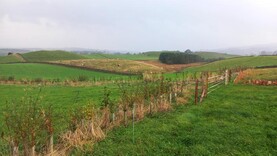Being from the northwest of the country, drought has been one problem that has never really been an issue.
Even prior to last weekend, ground conditions there had been quite sticky, with heavy rainfall over the course of last week. However, the windy weather over the weekend has seen a vast improvement in conditions.
As I travel south to the Thrive demo farm outside Cashel in Tipperary, the situation is very, very different.
Little to no rainfall over the past few weeks, combined with strong winds that seem to have sucked the last bit of moisture out of the ground, has resulted in grass growth plummeting.
Stress
The dry conditions are also causing the grass plant to come under stress.
As a response to stress, it is natural for the plant to try to put up a seed head – a survival mechanism to ensure the genetics of the plant have a chance to live for another generation.
This means that, even at relatively low grass covers, seed heads are emerging and grass quality has deteriorated quite rapidly.
Options
There are a few options available to the farm. Grass growth has dipped just below demand, but given that there was a decent bank of grass ahead of stock and with some silage ground now coming available for grazing, it could be much worse.
We would now be looking at feeding silage at pasture to slow down the grazing rotation
If the farm was heavily stocked, we would now be looking at feeding silage at pasture to slow down the grazing rotation.
For now, we will continue to graze as normal, but leave stock that bit longer than we would like in paddocks in order to get them grazed out.
In terms of grazing quality, it means that stock are consuming a poorer quality sward, which has to have a negative effect on daily liveweight gains. Hopefully, this will not be the case for long.
Priority stock
Although we are trying to finish as many of the cattle off grass at the end of the second grazing period as possible, the calves still need to take priority to ensure they are hitting growth targets.
The rumen of the calves is still very much in development and any disruption to their diet now could have long-lasting consequences, whereas the older cattle will be better able to bounce back after a short period of reduced nutrition.
For that reason, the calves are now starting to graze some of the aftergrass from first-cut silage.
While cattle will be looking for a move every time you are out herding and may seem unsettled, once you are away from them, they are quite content, as grass dry matter is very high, so less grass is meeting their daily requirements – from an intake point of view, if not from a growth point of view.
Keep an eye on average cover
Keeping an eye on the average farm cover over the next two weeks is important and if it continues to drop, we will be moving in with silage supplementation at grass.
We will avoid getting so short of grass that cattle have to be rehoused, as this will lead to higher costs in dealing with slurry from housed stock.
Try to maintain the grazing rotation around the 19- to 21-day mark. If it becomes any shorter, you end up chasing your tail and not giving the grass sufficient time for regrowth.
Feeding a little silage under the electric fence alongside grazed grass would be the preferred option.
The demo farm is lucky in that there is a diet feeder on hand, which makes supplementing at pasture much easier if it is needed.
Water
With temperatures set to increase towards the weekend, it is so important that water troughs are checked twice daily in the coming days and that both water pressure and trough capacity are sufficient for the number of stock supported by them.






 This is a subscriber-only article
This is a subscriber-only article










SHARING OPTIONS: